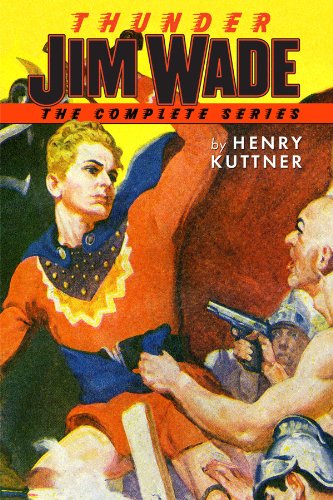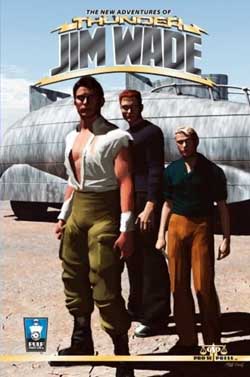
[Thunder Jim Wade] called himself a trouble-shooter. But he had a habit of seeking trouble, and smashing it with a cold, ruthless fury that had given him both name and reputation. His past was shrouded in mystery. Years before he had flashed on the scene like a comet—a comet whose mission was to destroy such men as Duke Solent.
Many had wondered whence Wade had come. But not even “Dirk” Marat and “Red” Argyle, Jim’s aides, knew that. Red was a burly giant with gnarled hands like knotted oak roots, and incredibly deft fingers. And Dirk was a small, innocent-looking chap with blond hair and black eyebrows, and one great passion. That was for cold steel. He could handle guns, but preferred to work with knives.
They helped Wade in his work—which was to smash crime and evil. Together they had wrecked opium rings, slave trades, pearl thievery, and a hundred other unscrupulous activities.
Kuttner, Henry. Thunder Jim Wade: The Complete Series (pp. 11-12). Altus Press. Kindle Edition.
* * * * *
In his namesake novella, Thunder Jim Wade arrives at Singapore to discover the whereabouts of his missing agent. During his investigation, he discovers that the agent was kidnapped while snooping into the disappearance of an archaeologist. After freeing the agent, Wade learns that criminal mastermind Duke Solent had captured both men and is on his way to Africa to find a mythical city and a missing treasure. From the clues, Wade discerns that the city in question is his childhood home, the last city of Cretan civilization hidden from the world inside a lost valley. Now Wade and his friends must foil Solent’s designs before this lost city is destroyed.
The Shadow’s breakout success in the 1930s spawned a new genre, the hero pulp. Filled with incorruptible men of vengeance and adventure, these heroes quickly spread throughout the pulp magazines. Except one. When Weird Tales published the adventures of Paul Ernst’s Doctor Satan, the readership revolted, driving out any story with so much as a hint of the hero pulp to it. However, in 1941, Henry Kuttner, one of science fiction’s grandmasters, turned to the genre, penning five novellas about Thunder Jim Wade, a South Seas hero in the mold of Doc Savage, despite the cape and tights that Thrilling Adventures‘ cover artists depicted him in. Unfortunately, the audience of the time considered Thunder Jim Wade to be a cheap Doc Savage knock-off, and Kuttner’s hero never found the sales needed to justify further adventures.
The “cheap Doc Savage knock-off” accusation are not entirely without merit. Like Doc, Thunder Jim Wade is a man of science, action, and justice. His pals Dirk and Red resemble Doc Savage’s close friends Monk, Ham, Long Tom, Johnny, and Renny, but while Doc’s team combine technical expertise with brawn, Dirk and Red are blue collar bruisers by comparison. A Pacific island serves as Jim’s Fortress of Solitude, conveniently lifted from Doc’s inventory, alongside the treasure of a lost civilization that enables Thunder Jim Wade’s war on crime. And it is no coincidence that Thunder Jim’s first adventure, like Doc’s The Man of Bronze, sent him to a lost valley civilization.

2012’s revival places Thunder Jim Wade in more fitting clothes to Kuttner’s South Seas setting than Thrilling Adventures’ superhero cape.
But the comparisons to Doc Savage are low hanging fruit, for Kuttner also mined The Shadow for material. Like Kent Allard, Thunder Jim spent time living among an isolated people, learning their ways and sworn to their protection from outside threats. Thunder Jim learned hypnosis and other mental arts from an exotic Asian people, employs disguises as convincing as The Shadow’s, runs an extensive network of named agents, and is as skilled an aviator as the Knight of Darkness. And Wade’s attitude towards the criminals he fights leans closer to The Shadow’s retribution than Doc’s rehabilitation.
But these strong resonances to these pulp heroes weighs lightly on Thunder Jim, little more than trappings instead of actual substance. Kuttner’s major innovation was to move his pulp hero out of New York, closer to the exotic lands of adventure of the Pacific, Asia, and Africa. In the process, Kuttner’s Singapore, likely no more real than a China Marine’s lurid sea stories, has a verisimilitude that the common underworld pulp tale–and the novella’s Cretan civilization–lacked. At the same time, Thunder Jim is diminished compared to his inspirations, merely human compared to the larger than life Doc Savage and the Shadow. Despite having a wide variety of knowledge and skills at his disposal, Thunder Jim relies instead on the direct approach and muscle-power. Among the many features emulated from Dent, Kuttner did not mimic the constant refrain of how peculiar and exemplary his hero is, and thus Thunder Jim seems to be ordinary for a pulp hero if not outright miscast, a two-fisted street detective that wandered into the wrong magazine. Also missing is the stage magic-inspired misdirection of the hero pulps; the realism and anti-Gothic tastes of Kuttner’s Campbelline circle of friends did not lend itself to the dramatic tricks that filled the hero magazines, as Babette Rosmund’s later editorial stints in charge of Doc Savage and The Shadow would prove.
But Thunder Jim Wade might not be entirely Kuttner’s creation. In 1941, he was newly wed to Catherine “C. L.” Moore, and, by merit of being the more prolific of the two writers, the breadwinner for their family. Thunder Jim Wade was not the first of his departures from science fiction to more lucrative writings, nor would it be his last, as science fiction in the 1940s was not a large enough market to support full-time writers alone. (Like many Campbelline era science fiction writers, Kuttner would turn to screenwriting, and eventually leave the genre entirely..) And entering the potentially lucrative hero pulps meant becoming a hired gun as a writer. Even Walter Gibson and Lester Dent worked with committees to develop their heroes’ adventures, and the editorial constraints of the lesser magazines could be even tighter. It is likely that the more derivative elements were editorial diktat.
Likewise, it is also probable that the contributions of his wife and frequent collaborator Catherine were minimal, too. Which is a shame. A touch of the stylings of Northwest Smith, akin to those in her story “Black Thirst”, would have livened both Thunder Jim Wade and his foster Cretan home.
Although competently written, as a hero pulp, “Thunder Jim Wade” adheres closely to the tropes and formulae of the genre, but misses the spirit. As such, the novella satisfies neither fans of the genre or fans of Kuttner’s science fiction and fantasy. But it still occasionally shines with flashes of brilliance, and none more brightly than its opening setting of Singapore.
Good review, Nathan. I’d been wondering about these tales.
Is that revival from Pre Se press a new work or repackage of the original works?
Actually, the outfit Thunder Jim Wade wears on that cover is correct.
If you read the first story, Wade gets in the garb of the Cretans during the big fight, and that is what we see on the cover. However, the one incorrect item is the hair color. He’s not blonde.
Altus Press reprinted the originals in one volume, Pro Se Press has been doing new stories.
Actually, of the 2 Pro Se volumes, the first is a collection of 6 short stories, the second is a single novella.